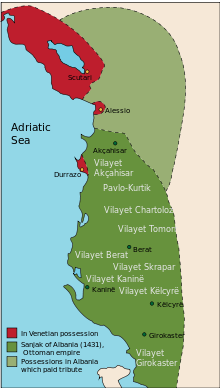

| Sanjak of Albania
Sanxhaku i Shqipërisë
| |||||||||||
|---|---|---|---|---|---|---|---|---|---|---|---|
| Sanjak of the Ottoman Empire | |||||||||||
| 1415–1444 | |||||||||||
 | |||||||||||
| Capital | Gjirokastër (since 1419) Vlorë (since 1431) | ||||||||||
| History | |||||||||||
• Established | 1415 | ||||||||||
• Disestablished | 1444 | ||||||||||
| |||||||||||
| Today part of | Albania Greece | ||||||||||
The Sanjak of Albania (Turkish: Sancak-i Arvanid or Arvanid-ili sancağı; Albanian: Sanxhaku i Shqipërisë) was a second-level administrative unit of the Ottoman Empire between 1415 and 1444. Its mandate included territories of modern central and southern Albania between Krujë to the Kalamas River in northwestern Greece.
During the 14th century, Ottoman rule began to extend over the Eastern Mediterranean and the Balkans. The divided nature of the Albania consisting of small, quarreling fiefdoms ruled by independent feudal lords and tribal chiefs meant that an Ottoman invasion was difficult to defend against. In 1385, the ruler of Durrës, Karl Thopia, appealed to the sultan for support against his rivals, the Balšić family. An Ottoman force quickly marched into Albania along the Via Egnatia and routed Balša II in the Battle of Savra. The principal Albanian clans soon swore fealty to the Ottoman Empire. The Ottomans allowed conquered Albanian clan chiefs to maintain their positions and property, but they had to pay tribute, send their sons to the Ottoman court as hostages, and provide the Ottoman army with auxiliary troops.[1]
The sanjak was established by 1415–17.[2] After 1431, the capital of the sanjak seems to have been Vlorë.[3]
In the 1431–32 period all rural and urban households and their property were registered in all ten districts of the Arvanid sanjak.[4] The 1432 register shows that districts in the Sanjak of Albania were further divided on 335 timars, each composed by two or three villages. The Arvanid register is one of the earliest available land registers in Ottoman Empire's archives,[5][6] and was published in 1954.[7]
In 1432 Andrew Thopia and Gjergj Arianiti revolted against the empire.[8] When the Albanian Revolt of 1432–36 began the sanjakbey of Albania was Ali Bey Evrenosoglu.[9] The uprising was finally suppressed during the 1435–36 campaigns of Ali Bey[10] and Turakhan Beg.[11]
In 1437, when Teodor III Muzaka revolted against the Ottomans, the sanjak-bey of Albania was his son Yakup Bey.[12] In 1437–38 Skanderbeg was appointed the subaşi of Krujë,[13] after which Hizir Bey was again appointed to that position in November 1438.[14] The first position of Hadim Sehabeddin Pasha outside the sultan's palace was the position of sanjakbey of the Sanjak of Albania, which he held until 1439 when he was appointed as beylerbey of the Rumelia Eyalet.[15] When in 1441 Përmet was annexed to the sanjak of Albania, Yakup Bey is mentioned as its sanjakbey.[16] He remained on the position of the sanjakbey of the Sanjak of Albania until September 1442[17] when he was killed as one of 16 Ottoman sanjakbeys under command of Hadim Sehabeddin Pasha who were all killed by Christian forces commanded by Janos Hunyadi in a battle near Ialomița River.[18]
Hadim Suleiman Pasha was the sanjak-bey of Albania briefly before becoming the sanjak-bey of Smederevo.[19]
The Sanjak of Albania was disestablished in 1444, after the League of Lezhë was formed. After Elbasan fell into Ottoman hands once again the construction of Elbasan Castle saw the establishment of the Sanjak of Elbasan. The new sanjak incorporated Isbat (Shpat) and Çermenika.[3] At the same time the Sanjak of Avlona (Vlorë) was established with the sub-districts (kaza) of Skrapar, Përmet, Pogon, Tepelenë and Gjirokastër.[3]
The newly occupied Albanian lands were organized into the sancak-i Arvanid ("sanjak of the Arvanids"), a military-administrative district subject to the larger Rumelia Eyalet (Ottoman Balkans).[3] The sanjak was subdivided into nine vilayets, sub-districts including a city and its surrounding villages, headed by beys.[3] The vilayets in turn were subdivided into nahiyes under the supervision of a naib (district-judge).[3] The Sanjak of Albania represents the first definition of Albania by the Ottoman Empire as a territorial unit, linking the Albanian language to a specific territory.[20]
In 1431–32 the Ottoman governor Umur Bey compiled a defter (cadastral survey) in the sanjak, which stretched from Krujë in the north to the Kalamas river valley in the south.[21]
| Vilâyet | Seat | Notes |
|---|---|---|
| Ergirikasrı[7] or Zenebis[3] | Ergirikasrı (Gjirokastër) | |
| Klisura | Klisura (Këlcyrë) | |
| Kanina | Kanina (Kaninë) | |
| Belgrad | Belgrad (Berat) | |
| Tomorince | Tomorince (Tomorricë) | |
| İskrapar | İskrapar (Skrapar) | |
| Pavlo-Kurtik | 20 timars (9 Christian).[7] | |
| Çartolos | ||
| Akçahisar | Akçahisar (Krujë) |
...and by 1415-1417 the province of Albania, Arvanid-ili or Arnavud-ili, was constituted.
Le sandjakbey d'Albanie, Ali bey Evrenos, partant de Gjirokastra, se porta aussitôt contre Arianite, mais les Turcs, selon le chroniqueur Oruc, furent battus à Buzurshek, dans la vallée du Shkumbin.
Pasi u larguan ushtritë turke të Rumelisë, shpërtheu aty nga viti 1437-1438 një kryengritje tjetër në rrethin e Beratit, e krye- suar nga Theodhor Korona Muzaka, biri i të cilit, Jakup Beu, ishte në atë kohë sanxhakbeu i sanxhakut të Shqipërisë
Şehabeddin's first post outside the palace was as sanjak governor in Gjirokastrës, Albania (Albania).47 in 1439, after the change in imperial policy ...
Yerli Hristiyan beylerden birisi olan Teodor Muzaka'nın oğlu Yakup Bey, İslâma geçerken, Osmanlı yönetimi kadrosu içine sokulmuş ve 1442 yılının dolaylarında Arvanid sancak beyi makamına kadar çıkmayı başarmıştır.3 Adı geçen sancağın
... e Shehabedin pashait e nga sanxhakbejlerët si Firuz beu, Jakup beu, i biri i Teodor Muzakës 30, e gjithsej pesëmbëdhjetë bejlerë pri- jësa ranë aty të gjithë dëshmorë. Shumica e jeniçerëve u grinë. Vetëm Shehabedin pasha u arratis.
{{cite book}}: CS1 maint: location missing publisher (link)|
Albanians under the Ottoman Empire
| |||||||||||
|---|---|---|---|---|---|---|---|---|---|---|---|
| History |
| ||||||||||
| Geography |
| ||||||||||
| Society |
| ||||||||||
| |||||||||||